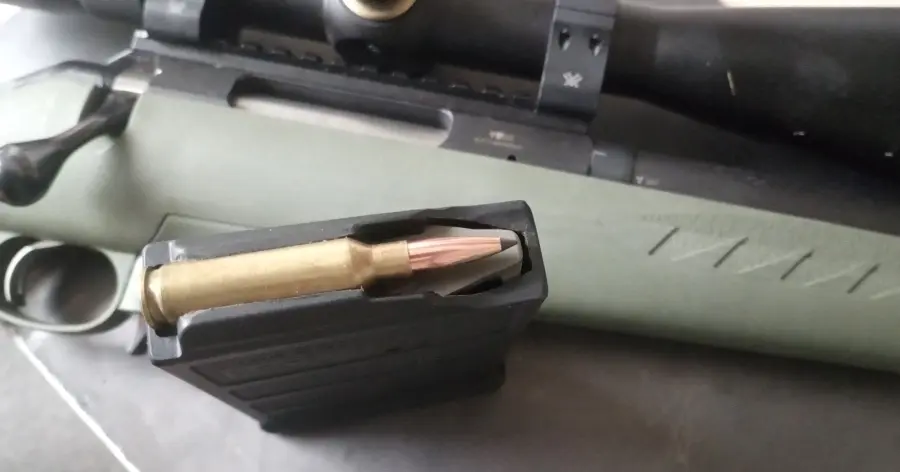For High-Velocity Rounds
The bullet has a core made of a special lead alloy prone to fragmentation, further supported by an extra-thin jacket. The rear section is somewhat thicker than the tip, but still thinner than usual. This is a bullet with a flat base and a hollow cavity into which a black polymer ballistic tip is inserted. The core begins a few millimeters below the edge of the jacket, creating a larger cavity that promotes bullet expansion upon impact and also shifts the center of gravity slightly to the rear, positively affecting ballistics. With a relatively low bullet weight, this usually ensures adequate performance.
Nosler offers its Varmageddon series bullets in the following sizes: (diameter/weight) .172/20, .204/32, .224/40,35,50,53,55, .243/55,90, .264/90, .308/110, and finally .310/123 for 7.62x39 mm cartridges, the only one featuring a crimping groove. Additionally, there is a variant with an exposed hollow point without a ballistic tip, available in .17/20 and .22/62 calibers. Unsurprisingly, the bullet performs best at higher impact velocities. The manufacturer doesn’t specify a minimum speed, but it should be around 600 m/s. In my case, with a 6.5 Creedmoor caliber, this translates to an effective range of about 450 meters. Typical “hunting” distances of up to 300 meters pose no issues. For this reason, I would avoid loading this bullet into .308 Win and 7.62x39 mm cartridges, which are at a disadvantage compared to the significantly faster and ballistically superior smaller calibers.
Hornady Competition
One of the main current competitors to the tested bullet is the V-Max from the equally renowned manufacturer Hornady. In purpose, characteristics, and terminal performance, it’s very similar to the Varmageddon. I wouldn’t personally pick a winner here; to me, it’s a tie. Perhaps the only difference is that the V-Max has a group size about 2 mm wider (at least in my firearm), but slightly better ballistics. Specifically, the Varmageddon .264/90 has a BC of .350, while the V-Max .264/95 has a BC of .365. In practice, these differences are negligible. The Nosler champion speaks for itself with a lower price; the V-Max is 3.9 CZK per piece more expensive. That’s no small difference, which inclines me to favor the Varmageddon as my first choice. Most shooters prefer to dispatch varmints as cheaply as possible, which is why some use affordable full metal jackets instead of true hunting bullets. However, in terms of terminal effect, the Varmageddon is a better option (unless you’re preserving the hide). On the other hand, the V-Max’s advantage is its availability in both individual bullets and factory-loaded cartridges, used not only by Hornady but also by Federal. For reloading, I’d go with Varmageddon; for factory loads, I’d logically recommend V-Max.


Nosler also produces factory-loaded cartridges with Varmageddon series bullets, though they are currently unavailable locally.
Short Bullet
I tested the “doomsday for varmints” bullets in .264 diameter with a weight of 90 grains, paired with a 6.5 Creedmoor cartridge in a Ruger American Predator rifle with a 559 mm barrel. This caliber, thanks to its relatively high velocities, is an ideal candidate for loading with Varmageddon bullets. As usual during reloading, I prepared several sets with three seating depths and two different charges of the reliable Vectan SP 11 powder.
A potential issue with reloading in some calibers (including mine) is the short length of the bullet. In my case, the bullet is only 26 mm long, leaving minimal neck engagement. Therefore, I seated it slightly deeper than standard. The highest accuracy was achieved with a total cartridge length of 70 mm (with neck contact of barely 5 mm) and a charge of 49 grains. The measured muzzle velocity averages an impressive 1,006 m/s, yielding an energy of approximately 2,950 J. Despite the short length and light weight, the ballistic coefficient remains respectable at .350. For the purpose of this test, I weighed 10 randomly selected bullets from the box, and the weight deviation was negligible. Upon closer inspection, these are high-quality bullets. There’s nothing to criticize—typical Nosler quality. The ballistic tip shows no signs of deformation and withstands reloading and regular handling. Additionally, despite its relatively thin jacket, the manufacturer states it should withstand firing even with the highest-velocity rounds.
At the Range
The cartridges are highly accurate; Nosler is among the best manufacturers in this regard, and Varmageddon is no exception. Range testing (after finding the optimal powder charge and bullet seating depth) involved firing two sets of 6 cartridges each at 100 meters, with the worst shot from each set excluded and the results averaged. The measured group size was 15 mm for the first set and 17 mm for the second set. This is an excellent value, indicating potential for longer-range shooting. Other hunters’ experiences also attribute sub-MOA accuracy (26 mm at 91 m) to this bullet, with generally good tolerance, making it easy to match the Varmageddon to specific firearms. Additionally, other cartridge configurations I assembled for the test also performed well, with group sizes around 22 mm at 100 meters.
Being a fairly light bullet with relatively low sectional density (ratio of diameter to length), it naturally maintains velocity less effectively, but the initial speed is high, and ballistics are decent. I recorded a drop of 72 mm at 200 meters and 162 mm at 300 meters (sighted at point of aim at 100 meters). For Nosler’s standards, Varmageddon is surprisingly affordable. The .246/90 bullet I tested costs 10.2 CZK per piece, while, for instance, the .224/55 is 8.3 CZK each, and the .243/70 is available for 8.8 CZK each, with all variants packaged in boxes of 100.

Accuracy is outstanding. After tuning, I achieved a group size of around 15 mm at 100 meters, making it suitable for shooting beyond typical hunting ranges.

The distinctive Varmageddon ad leaves no doubt about the primary use of these bullets. As the sign says, “The end is near”—at least for the bullet's carrier, that is certain.
Varmint Shredder
A downside of these bullets is their highly destructive effect on the target. If you’re shooting a fox or groundhog, hoping to preserve the pelt, this isn’t the best choice. The terminal effect is indeed violent. It’s not uncommon for the target animal to literally explode into pieces. Personally, I’ve only shot one fox with it so far—as I rarely have opportunities for small game—but even then, I wouldn’t post a photo of the wounds, as it’s not a pleasant sight. Partial evisceration and the condition of the hide would require a lot of stitching to make a usable pelt. It’s simply one of those “explosive” bullets.
If you want proof, there are plenty of truly explosive videos readily available on YouTube. Based on more experienced hunters’ notes and my own experience, I can confidently say that this bullet is forgiving of poor shot placement, and game of appropriate size drops immediately, often right on the spot. I am convinced that beyond varmints and pests, it could be used to hunt smaller game like roe deer, but due to its destructive nature, it would be a waste of meat. Conversely, if you are strictly taking headshots, then it’s a valid option. Again, it’s not a pretty sight, but you can be nearly certain that the terminal effect will be more than sufficient. However, it’s definitely not suited for larger, trophy game or, heaven forbid, wild boar. That likely wouldn’t go well. Varmageddon is simply not a universal bullet, which may deter some hunters, but as a specialized varmint round, it excels.
Advantages/ Disadvantages
+ Excellent accuracy
+ Exceptional terminal effect
+ Low, almost bargain price
- Not suitable if you wish to preserve meat or hide
- Specialized for small game, not a universal “do-it-all” bullet
Nosler Varmageddon bullets can be purchased at STROBL.CZ s.r.o. More information can be found at strobl.cz or directly on the manufacturer’s website - nosler.com.
Photo sources: Author’s archive, materials from the manufacturer – nosler.com, Hornady.com















